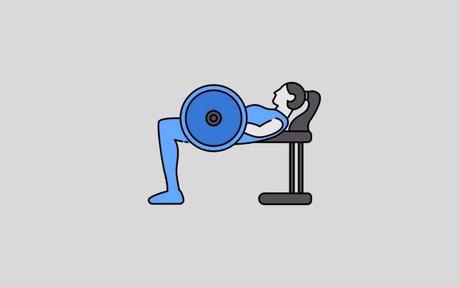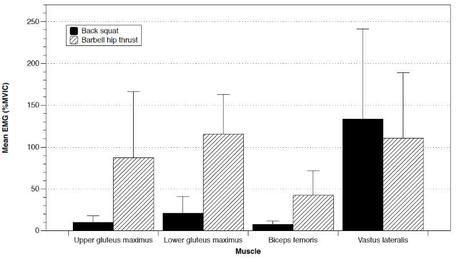The barbell hip thrust is a killer exercise for developing lower body strength and muscle. Here’s a detailed look at what muscles are being worked when doing hip thrusts.

The hip thrust primarily works the glutes and hip extensors, as well as the lower back (erector spinae), knee extensors, and the quads.
Together, the primary muscle groups combine to create tremendous horizontal power and increase muscle activation in the glutes better than just about any other exercise in the gym.
Translation: Big ole booty muscles.
In this article, we will take a closer look at the muscles that are engaged in the course of a hip thrust, some ways to target different muscles around the glutes, and more.
Let’s dive right in.
The Hip Thrust – Overview
The barbell hip thrust is a relatively new exercise in the gym.
And it’s also one of my favorite all-time exercises for developing power, improving my posture, and developing a thicker booty.
Sliding under the barbell, wrapping it with a hip thrust pad, and launching the bar into the air is my favorite way of increasing muscle along my rear-end.
Although it looks a little goofy to those new to the exercise—you’re essentially dry-humping a barbell skywards, after all—this exercise is top of the pile for glute activation.
A study in the Journal of Strength and Conditioning Research showed that the hip thrust activates more glute muscle fibers than the back squat and split squats1.
Because the exercise is horizontally loaded, and because it decreases hamstring activation to complete the movement (unlike other glute-centric exercises like RDLs and Good Mornings), I’d argue that the hip thrust is an essential exercise for just about everyone.
Some of the key benefits of the hip thrust include:
- Is a useful exercise for both beginners and experienced lifters
- Safer than many compound exercises designed to target the glutes
- Easier to isolate the glutes and hip extensors (targeting the glutes 1.5 to 3x better than squats)
- Develops a ton of horizontal power, making it ideal for athletes2.
Hip Thrust – Muscles Worked
The barbell hip thrust works the biggest muscle that makes up your rear end—the glutes!
The primary muscles worked in the hip thrust include:
- Upper gluteus maximus
- Lower gluteus maximus
- Biceps femoris (hip extensor)
Secondary muscles worked:
- Erector spinae (lower back muscles)
- Quadriceps
- Hamstrings
- Adductors
Does the hip thrust build glute muscles better than squats?
Just how effective is the hip thrust for building muscle in the glutes?
Very, according to a few research papers that compare this exercise to other movements and exercises.
Although the squat and deadlift are the usual exercises used for building a strong back-end, the hip thrust blows them both out of the water.
One of the first research papers that took a deeper look at muscle activation of hip thrusts (and how they compared to back squats), was done by Bret Contreras and published back in 20153.
The study took a group of well-trained women and had them do a series of barbell hip thrusts and back squats, measuring muscle activation using electrodes.
The increased activation when doing hip thrusts was staggering, outperforming the back squat handily when it came to firing up both glute muscles and the biceps femoris (hip extensors). The back squat edged the hip thrust when it comes to developing quad muscle.

While this was one paper, and far from a “this is the final say!” type of result, it does provide a startling indication of how well this form of exercise works the glute muscles.
Hip Thrusts – Muscles Worked: FAQ
What are hip thrusts good for?
Hip thrusts, and their brother from another mother, glute bridges, are an excellent way to target the glutes.
Barbell hip thrusts are also excellent for developing lower back strength, increasing speed and explosiveness, and they are a safer alternative to many compound lower body lifts for beginner and intermediate lifters.
What is the difference between a hip thrust and a glute bridge?
Hip thrusts are done with your shoulders elevated, typically using a workout bench, stacked aerobic stepper, or even a plyo box to elevate the shoulders.
This elevation increases the range of motion of the exercise. A glute bridge is done with your shoulders on the ground.
There are excellent reasons to have both in your workout arsenal. Glute bridges, in particular, are one of my favorite exercises to incorporate in my dynamic warm-up.
Do hip thrusts make your thighs bigger?
The hip thrust is a killer exercise that can help develop size and muscle in your glutes, but it’s not a glute-only exercise, which can be frustrating for those looking to get a stronger back-end without adding size to the thighs.
A classic hip thrust engages the hamstrings and quads, and for women (and men) who have muscular thighs and want to balance out their physique, it can get tricky adding hip thrusts to their training routine without also piling on more muscle elsewhere.
For gymgoers facing this dilemma, a variation to try is the barbell glute bridge. The shorter range of motion helps reduce quad and hamstring stimulation without sacrificing growth in the glutes.
Additionally, remember that glute activation peaks at the top of the movement, when your hips are fully extended. Consider adding 3-10 seconds of isometric hold at this position on your final rep of each set to make the most of the glutes firing on all cylinders.
Other exercises that you can do to stimulate glute growth without also firing up the quads and hamstrings are kettlebell swings, hip abduction movements (banded lateral abduction, lying abduction raises, and so on) and even pull-throughs on a cable machine.
The Bottom Line
The hip thrust is an excellent and effective exercise for strengthening the backside of the body, which often gets neglected and even atrophied from long bouts of sitting and inactivity.
If you’re new to the hip thrust, start off with a glute bridge or doing a hip thrust without any weight to get your technique dialed in.
Ultimately, the hip thrust is a killer addition to anyone’s workout routine, whether you are a weekend warrior, elite athlete, or someone who simply wants a more muscular booty.
More Hip Thrust Content:


